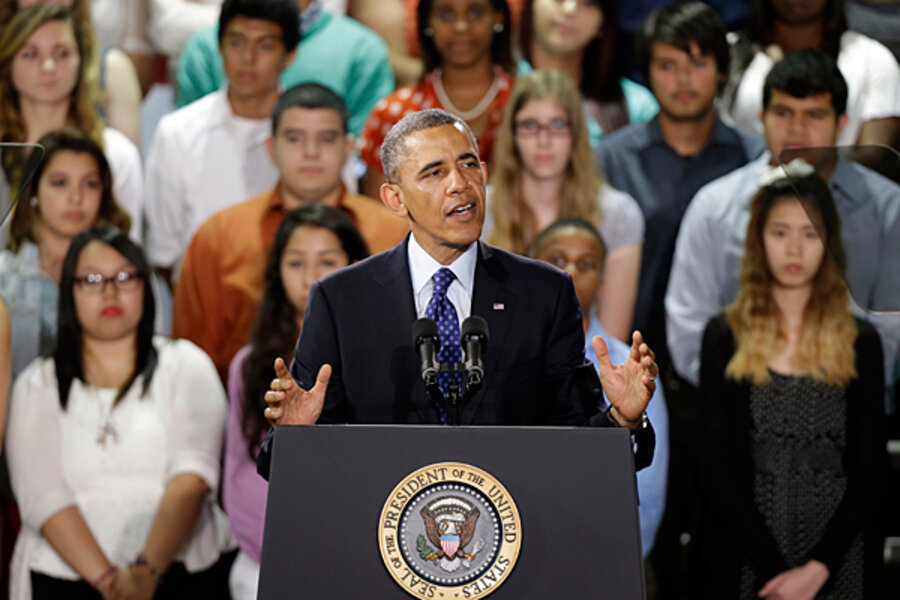In Texas, Obama lauds 'New Tech' high school. Model for the future?
Loading...
President Obama kicked off his “Middle Class Jobs & Opportunity Tour” Thursday with a visit to Manor New Tech High School in Manor, Texas, where he met some of the students that will help make up the 1 million new graduates he hopes to see in the fields of science, technology, engineering, and math (STEM) over the next decade.
The school is part of the nationwide New Tech Network (NTN), a nonprofit that works with 120 schools that exemplify many of the educational innovations the Obama administration has supported to better prepare students for college and modern-day careers.
“Our economy can’t succeed unless our young people have the skills that they need to succeed – and that’s what’s happening here,” Mr. Obama said to a gathering of students, teachers, and dignitaries at Manor.
NTN schools, 90 percent of which are in public districts, are built around student-centered projects that have real-world connections to local businesses and nonprofits. Digital tools are integrated into everyday learning: Instead of textbooks, students carry around laptops or tablets. When students graduate, they already have college credits under their belt.
The network provides a “model of how to prepare students for the world they are coming into,” says Linda Darling-Hammond, an education professor at Stanford University, because students master the top skills in demand in Fortune 500 companies today: “teamwork, problem-solving, and interactive communication.”
Unlike the old model, where vocational education was a separate track from college-prep, Ms. Darling-Hammond says, “students in New Tech are simultaneously prepared for college and careers…. They say, ‘We learn math because we see how it’s applied … and we understand it more deeply.’ ”
The schools, currently in 18 states, reach a diverse group of students. Most of Manor New Tech students, for instance, qualify for free or reduced-price meals, and most of them go on to become first-generation college students.
NTN students graduate at a rate 6 percent higher than the national average. They also enroll and persist more in college. At 2-year colleges, for instance, they stay enrolled at a rate 46 percent higher than the national average.
“Every day, this school is proving that every child has the potential to learn the real-world skills they need to succeed in college and beyond,” Obama said, after meeting students who were studying how earthworms regenerate and using math to build musical instruments and robots. “You’re doing things a little differently around here than a lot of high schools, and it’s working,” he said.
The ubiquity of computers and online access at the schools is not about technology for technology’s sake, says NTN president Lydia Dobyns. “Without the context and the training, simply providing laptops or iPads is highly unlikely to change the outcomes for students.”
Teachers at network schools, particularly at Manor, “exemplify what can happen when teachers work in a collaborative, transformative way,” Ms. Dobyns says.
Their broader goal is to foster deep learning, measured in part by the College and Work Readiness Assessment (CWRA) – which looks at analytical reasoning, writing effectiveness, writing mechanics, and problem-solving. NTN students gain 75 percent more points between freshman and senior year than their peers in other schools who take the CWRA.
Teachers in the network have used Facebook and Twitter to teach social-media responsibility. They’ve engaged students in civics by having them create their own political parties and campaign videos, culminating in an online debate among the top candidates from the schools in the network, according to an Education Week blog by Tom Vander Ark, a consultant on education reform and managing partner of Learn Capital.
The network offers an online platform where students and teachers can collaborate, and where multiple schools can share resources and successful project ideas.
Students at Manor have participated in robotics contests, worked on projects with the company Samsung, and tapped the website Rally.org to raise money for everything from prom to a roller derby team.
The first New Tech high school started in Napa, Calif., in 1996. Among graduates of that school, 43 percent have entered STEM careers, says Matt Williams, a spokesman for KnowledgeWorks, the nonprofit that oversees NTN.
With the help of federal grants such as Race to the Top and Investing in Innovation (i3), some states have integrated NTN schools into their plans for improving both education and economic development. Indiana, for instance, now has 23 network schools.
Obama’s April budget contained a proposal for a $300 million High School Redesign competitive grant program for districts that partner with colleges, businesses, and nonprofits to develop the skills needed for future jobs.
He used his visit to Manor Thursday to once again push for such initiatives, as well as his proposals to expand high quality preschool opportunities and help make college more affordable.
How much financial support he can really throw behind such educational initiatives will depend on the real budget that Congress eventually passes.
But whether Obama gets all the dollars he wants or not, schools – and even some whole school districts such as in Sacramento, Calif. – that follow principles similar to those of the New Tech Network are springing up all around the country “because the workforce is demanding these skills,” says Bob Wise, president of the Alliance for Excellent Education in Washington, which promotes improvements in high schools.
“One CEO said to me, ‘We don’t hire people for what they know but for what they can do with what they know,’ ” says Mr. Wise, the former governor of West Virginia.








